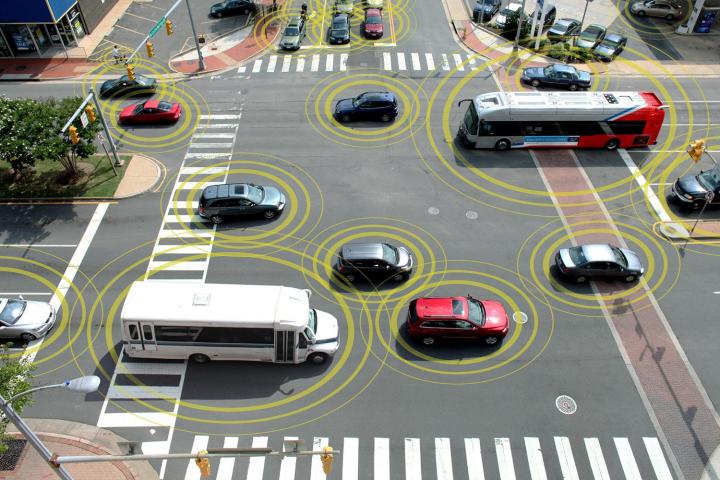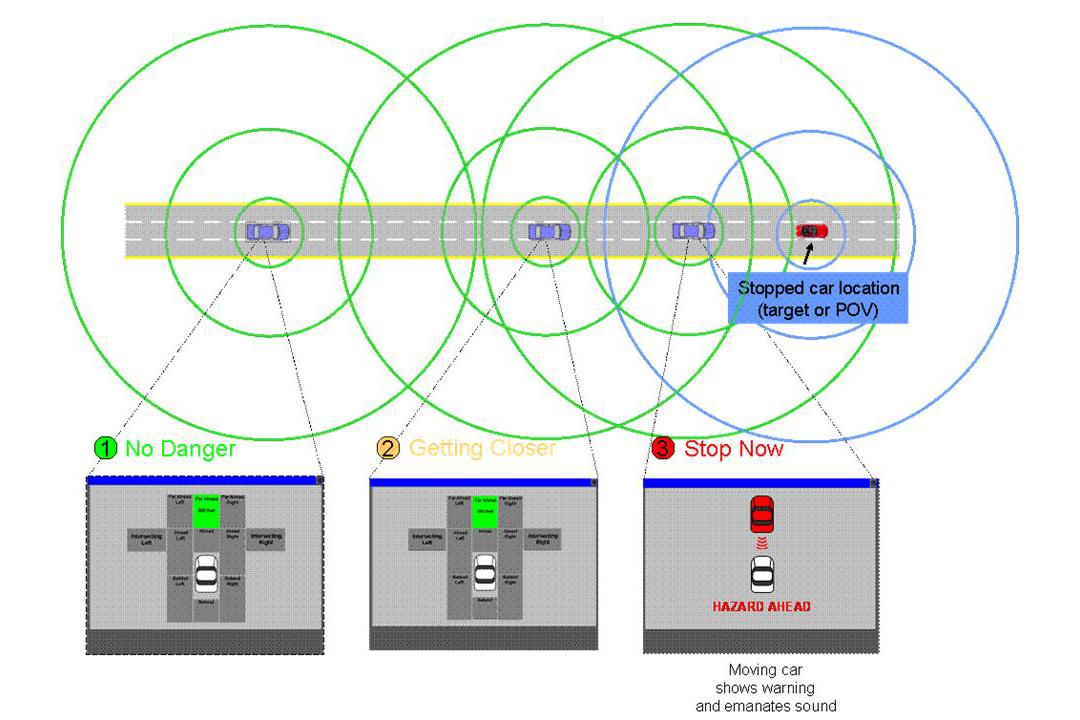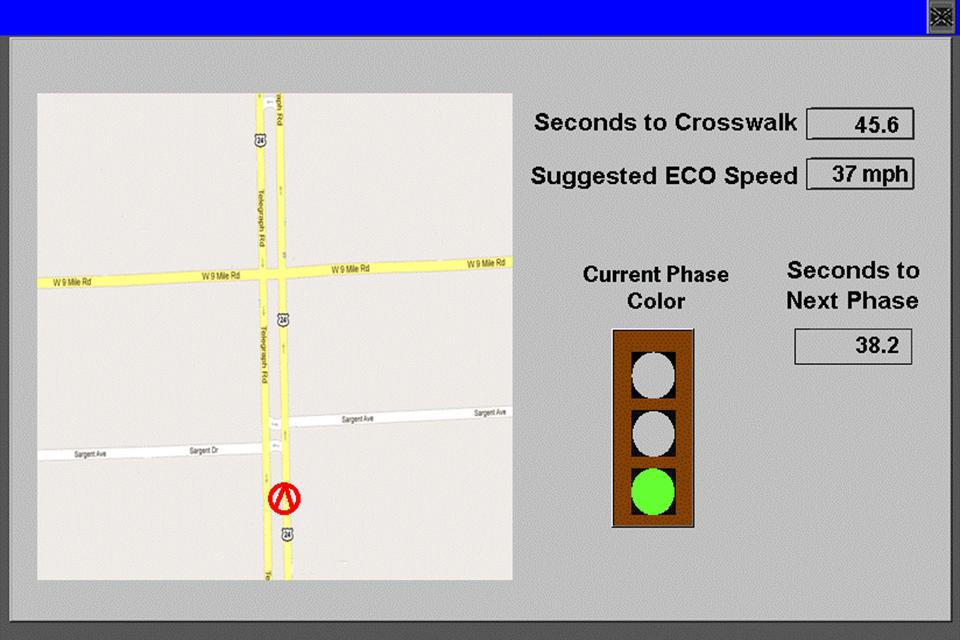
The solutions to those challenges involve expensive sensors and complicated software development – think the Google car that has the big, bulbous sensors on its roof. Short of slapping tech roof systems on new cars, there is another way to solve the issues currently facing piloted driving … and it literally involves thinking around corners.
It’s called car-to-car communication, and we spoke to one of the leaders in the field, Roger Berg, Denso’s Vice President of Wireless Technology, to find out how the proliferation of car-to-car tech could not only allow piloted cars to driver more safely in bad weather but also how the tech can make cars more efficient as well.
What is a connected car?
Before we dive into connected cars and how it works, let’s first get a grip on just what a connected car is. In the field of autonomous cars being “connected” boils down to cars being able not just to talk to one another, but also to the infrastructure on which they drive.
For Denso, this means using two technically similar but distinct technologies. The first is vehicle-to-vehicle communications or, as Denso calls, it V2V. While a number of companies have either pursued or at least discussed ideas like this, Denso actually has a technology ready for production.
From a technical standpoint, V2V is essentially a small box, about the size of a hardcover book, mounted either on the dash or A-pillar. The core of this box is essentially a Wi-Fi router, albeit one with a stronger signal. The V2V box can send and receive signals to and from other cars on the road in a 300-meter radius in urban areas and up to a kilometer on flat open ground.
V2X allows the car to communicate with the road infrastructure.
As Berg explained, range is crucial for the system to work as expected, but also a real challenge. The urban environments where cars spend so much time are minefields of reflective surfaces and constricted sight lines. To get the impressive range they did, Denso’s engineers had to not just create a powerful transmitter, but also some devilishly clever software capable of sorting real signals from a sea of echoes.
Berg explained that connected tech doesn’t end at V2V. Almost as important is technology dubbed “V2X.” This system uses the same technology as V2V but rather than sending signals to other cars, V2X allows the car to communicate with the road infrastructure. In fact, the same in-car box that can talk to other cars can be used to communicate with the electronics that operate stoplights, on-ramp meters, and message boards.
Why is it so important?
The technology behind Denso’s V2V and V2X systems is impressive. It’s what these systems allow, however, that is truly groundbreaking. Berg explained that the chief goal of these technologies is to revolutionize our approach and expectations for road safety.
The reality is that no matter how good active safety and autonomous driving systems get on individual cars, there will always be large gaps in what they can sense and understand. Take our recent article about the pitfalls of current autonomous tech, which is limited by sensors that are hindered by darkness and bad weather – amongst other factors.
That’s where connected car tech comes in. By communicating with other cars on the road, each individual car can get a picture of its entire environment, warning the driver of potential hazards long before they would be visible to either the driver or the car’s own sensors.
Not only would such systems be able to supplant any missing information gathered (or not gathered) by cameras and radar in bad environmental conditions, they could also warn of threats that may not be easy to detect by these systems altogether. For example, Denso highlights the potential for V2V and V2X technology to send warnings alerting drivers of a driver behaving erratically, allowing commuters to avoid the problem vehicle before it presents a direct risk.
As important as safety is, there are other potential gains, too. The V2X communication could allow for much faster and more efficient driving. By reading the traffic flow, lights could be metered far more effectively, creating more efficient paths of travel, or, in light traffic conditions, giving drivers clear “green paths.”
There is also room for environmentally “green” improvements. One Denso pilot program created convoys of tandem, tailgating semi-trucks, in the hopes to both reduce the space taken up on the highway by the vehicles but also improve fuel economy. Efficiency was improved by keeping the trucks so close together that the second truck could fall into the first truck’s slipstream, allowing the second truck to operate more efficiently, as it didn’t have to expend energy to break through the air. The result was a five percent improvement for the lead vehicle and a ten percent improvement for the follow vehicle.
Unfortunately, these results would be difficult to replicate with passenger vehicles because of the entirely different aerodynamics. However, it is possible to imagine improvements in traffic flow by linking cars together in V2V-controlled and calculated convoys.
When is this technology going to show up?
So if all of this technology exists, and offers such dramatic potential, why isn’t it already on new cars? Unfortunately, there are several hurdles that need to be overcome before V2V and V2X is proliferated through the new-car market.
The first and probably most important hurdle is a legal one. V2V and V2X technology has received significant support from the National Highway Transportation and Safety Administration (NHTSA). But before the technology becomes broadly implemented and even mandatory, the NHTSA will need to make rulings and conduct studies to insure the technology is safe and secure in the real world. This could happen as quickly as the next two to three years. Before that happens, however, a few serious issues need to be addressed.
There is, rightly, growing concern regarding the security of the technology in cars. As it stands, several demonstrations have already shown that cars are vulnerable to hacking, and a widespread increase in wireless communication by cars will only exacerbate this issue. Berg told us that Denso is working hard on this issue, using both in-house engineers and consultants to create a digital defense in depth. However, this will be an issue to keep an eye on.
Lastly, there is the issue of funding. If V2V technology is mandated, it will at least slightly increase the price tag of cars as automakers either develop their own versions of the systems, or more likely contract with suppliers like Denso. V2X will be more of a challenge, as it will require retrofitting large amount of publically owned infrastructure. The national infrastructure budget is already strapped to the point where badly needed maintenance is not being done. With this environment prevailing, V2X technology will need to find alternative sources of funding.
Conclusion
Connected car technology is a crucial part of the future of transport, not to mention an obvious extension for the sort of networked solutions that have become commonplace in most tech fields. Technologies like those proposed by Denso could dramatically improve road safety, which annually takes a toll of more than 32,000 lives, not to mention address increasingly critical issues of efficiency and traffic congestion.
This will be true regardless of its integration into autonomous cars. That being said, it is very hard to imagine a world of autonomous cars that don’t make extensive use of V2V or V2X systems. We at Digital Trends expect the growth of these two technologies to rely on one another as they each become increasingly common.
Editors' Recommendations
- How a big blue van from 1986 paved the way for self-driving cars
- Watch San Franciscans take a ride in Waymo’s self-driving car
- Uber gives up on developing its own self-driving car
- Waymo puts its self-driving cars back on Arizona roads as lockdown is eased
- Qualcomm’s self-driving car made me never want to touch a steering wheel again




